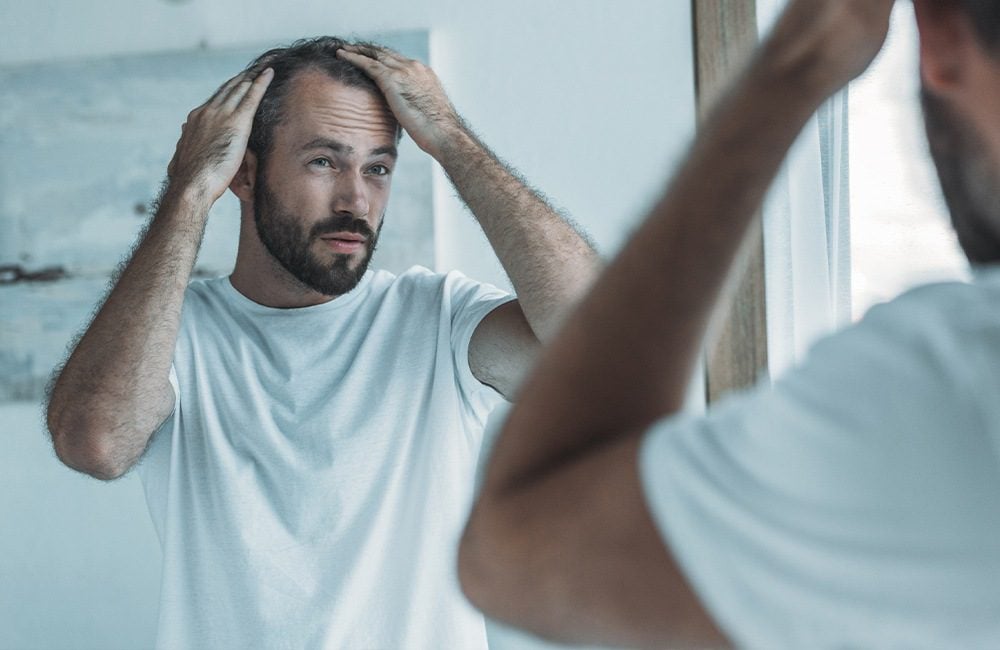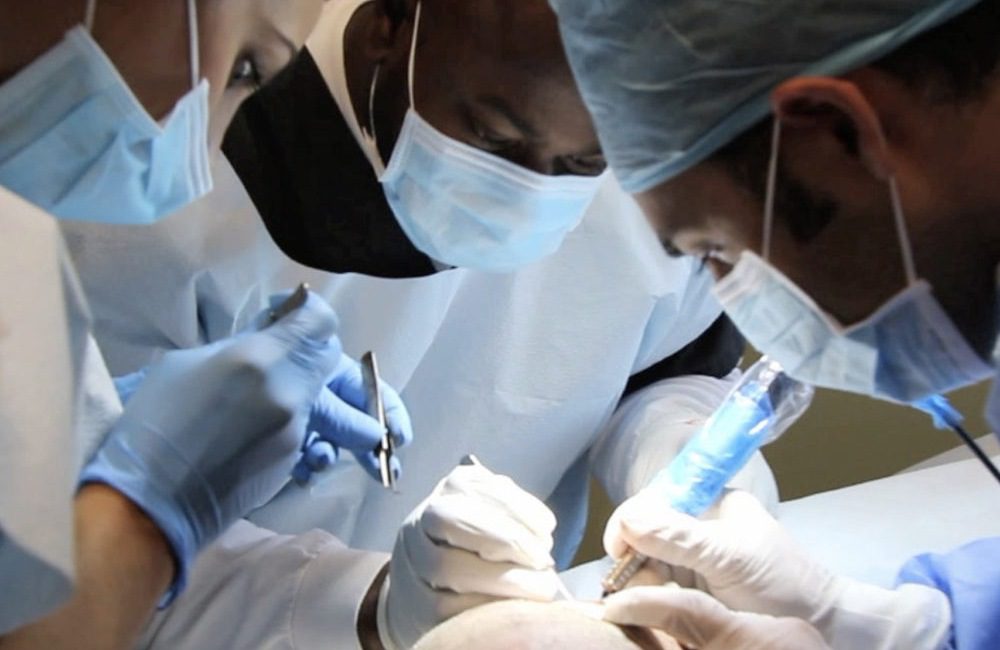Everything You Need To Know About Hair Transplants Before Getting One
As a seasoned veteran of 13 hair transplants I would say I’m a fully-fledged authority on the topic. Add to that my immersion in the hair loss treatments industry as a patient advocate and mentor and you can feel confident that you’ve come to the right place to learn about hair transplants.
Buckle up because things are about to get a little gory.
When Should You Consider A Hair Transplant?
Typically, a man experiencing male pattern baldness would not rush straight into a hair transplant surgeon’s office. I would recommend trying other preventative treatments before ultimately deciding on a hair transplant. Surgery is always the last resort.
There are a wealth of hair vitamins, supplements, topical treatments, shampoos and conditioners to trial first and have as part of your defence regime, especially if you want to increase your scalp health and get your existing hair in the best condition possible. However, the most important thing to do is address the most common cause men lose their hair: dihydrotestosterone (DHT).
DHT is the main known factor that causes hair loss. It is produced thanks to your body’s 5a-reductase enzyme converting free-roaming testosterone to DHT inside the hair cell follicle. This DHT then binds to the hair cell receptor and causes it to atrophy or shrink. Eventually your hair follicle stops producing hair and you lose that follicle forever.
If you want to hold onto your hair, it is imperative that you try to stop hair loss via proven treatments as soon as possible. The two scientifically-proven products that have been FDA-approved for dealing with hair loss are Finasteride, a prescription drug that blocks DHT conversion, and Minoxidil (widely known as the brand Regaine in the UK), which improves circulation and blood flow to the scalp and encourages hair to grow. I’ve also personally had success with hair loss shampoos, specifically groMD’s version, which are designed to give your hair the very best platform for growth.
Is There An Age Limit On Hair Transplants?

There really is no lower or upper age limit on candidacy for a hair transplant. What matters is the patient’s overall health condition and suitability for the procedure. If hair loss is impacting negatively on your life so much that you’re avoiding socialising, withdrawing from opportunities at work/in relationships and experiencing depression or anxiety then – after discussing your situation with your GP and considering therapy – you might want to explore a hair transplant procedure.
It’s also a good idea to at least meet with a surgeon well before you intend on having surgery. That way, you’ll know whether you’re a genuine candidate for the surgery and the surgeon may recommend some treatments to undertake before your transplant.
How Much Does A Hair Transplant Cost?
Hair transplant surgery typically starts at around £4,000-6,000 and can go up to as much as £20,000 depending on how many grafts you require. Expect to pay around £3 per follicle for FUT and £5 per follicle for FUE.
How To Find A Reputable Surgeon
This is key to your transplant success and your overall health and happiness: you need to find a reputable hair transplant surgeon, not some random guy running using influencers to run a slick advertising campaign on Instagram.
A high-quality, ethical surgeon will always preach surgery as a last resort. Word of mouth or a personal recommendation is obviously ideal (if the person’s results were good) but by far the best place to look to find a reputable hair transplant surgeon is the IAHRS database (International Alliance of Hair Restoration Surgeons).
IAHRS is a worldwide organisation that admits as its members only those physicians who represent the best in the discipline. If none are within your proximity then a Google search in your area should show local operators, but always be prepared to travel to find the right surgeon for you. It really is that important.
Draw up a shortlist of potential surgeries and then investigate each physician directly. Seek out reviews, patient testimonials, positive and negative media mentions and look up the practice on fair trading or consumer rights websites. I’ve personally had surgery with several clinics over the years – good and bad – and my most recent hair transplant was with The Harley Street Hair Clinic in London.
Once you find a couple that you feel are reputable, go and meet with them. Take a list of questions, ask to see patient before and after photos, request a tour of the practice and gauge how you feel about their patient care, customer service, professionalism and expertise.
What Happens At The Initial Consultation?

At your first consultation, you will complete a medical questionnaire about your general health, medical history and what treatments you have tried in the past. Your scalp will be examined to determine the extent and type of hair loss and to ascertain the most appropriate course of action. Scans and measurements will be taken as well as ‘before’ photographs.
If you are deemed to be an appropriate candidate for surgery, you will receive a full explanation about the procedure, the anaesthetic involved, expectations, risks, costs and what you can expect both in the weeks and months following the surgery and in terms of results.
What’s The Lead Time For Surgery?
Your surgeon’s availability and your specific situation will determine how long you will have to wait for surgery. Expect to a lead time of around one month. It could be more, it could be less depending on the clinic’s popularity and availability due to COVID19.
Preparation For Your Hair Transplant
You may be asked to have an ECG or blood tests, and you will have to stop taking any blood thinning or anti-inflammatory meds, antidepressants, beta-blockers, vitamins and herbal supplements at certain points in the timeline.
Smoking and alcohol consumption will also have to stop at a certain point to ensure your body and scalp are in optimal condition.
The Surgery & Hair Transplant Techniques

The two extraction techniques used when it comes to hair transplants are follicular unit transplantation (FUT) and follicular unit extraction (FUE). FUT involves removing a strip of tissue from your designated donor area. This area is then stitched or stapled up. The removed section of scalp is carefully dissected down into individual follicular units (FU) and should be performed under high magnification.
FUT surgery leaves a relatively small linear scar in the donor region that often can be hidden with a low grade haircut when a surgeon preforms it competently and the patient’s physiology complies. FUT traditionally has always been deemed more suitable for patients with extensive baldness and who have larger size session requirements.
With FUE, follicular units are extracted individually using specialist tools and it’s deemed a much more appealing technique as it is less invasive and any scarring is not as noticeable in the donor region. That said, you should still expect there to be scarring and FUE is still very much surgery.
No matter which extraction technique you and your surgeon prefers, once extracted the follicular units are relocated to the transplant site using a surgical needle/implanter. This needs to be done in a timely manner, which is why the surgeon will require the help of highly trained and dedicated technicians.
The surgeon will start by making tiny precise incisions in your scalp for the hairs/grafts to be inserted into. If done incorrectly scarring and pitting may occur – this is just another reason why you need to choose an experienced, skilful surgeon. It’s a labour- and time-intensive process and rarely will you have a surgeon do this all themselves, instead using their technicians to implant the FU into the holes.
Recovery Following Hair Transplant Surgery
Around three-to-four hours after surgery, your anaesthetic will wear off and you may feel some pain and discomfort. You could also experience a bit of swelling of the scalp, which should return to normal within a few days. Your surgeon or practice team will provide you with information about recovery and how to best look after your hair and scalp after surgery. You might also be prescribed an antibiotic to take.
It’s advisable to sleep semi-upright for the first few nights, avoid alcohol for 48 hours, smoking for a month, sport and other strenuous activities for at least a couple of weeks and sun exposure for three months. You must simply respect the process and your investment. You should be particular cautious of your hair transplant in the first 24-72 hours after surgery, while your scalp is still swollen and red.
If you experience any significant bleeding or other discharge, pain that won’t go away with Paracetamol or swelling that won’t settle, you should reach out to your surgeon’s practice.
Ongoing Maintenance After A Hair Transplant
Irrespective of the method used, you can expect to lose your transplanted hair at around the two-to-three-week mark. This is normal and over the following months, the hair will begin to grow in. Don’t brush your hair for as long as possible after showering and only towel dry your hair gently for the first five days as you need to allow the new hair to heal up and take root.
Take as directed any medications your surgeon recommends and use any hair loss products as advised. Your surgeon knows exactly what you need and by following all directions, your results will be better and your recovery easier. Many different clinics have slightly different post-op protocols so don’t worry too much if you read something online that differs from your regime. Follow your surgeon’s advice to the letter.
How Long Before You See Results?
Most patients experience around 50-60% of new growth after six-to-nine months, in accordance with your hair’s normal growth cycle. You can expect to achieve a natural-looking head of hair which conceals any bald areas and can be styled normally, but you need be very patient as the full results take a minimum of 12-18 months to fully mature.
When Might You Need Another Hair Transplant?
Your first hair transplant will improve the overall density of hair, the shape of your hairline and repopulate your balding areas. The majority of patients come away from their first transplant very happy with the results but often think that because the first one worked so well, another one will be even better. It seems hair is like money – you always want more.
Most hair transplant surgeons will insist patients wait at least 10-to-12 months before embarking on another procedure because of the natural growth cycle. In that time, your transplanted hair will have grown out and revealed an accurate picture of how your hair performs. The texture, length and diameter can be examined to determine the full outcome.
Few people just get one hair transplant because don’t forget, hair loss is progressive and the non-transplanted hair will continue to fall out in line with your genetics. So you need to go into it with your eyes open and be aware that this could end up being a long-term investment if you want to maintain your hair for the remainder of your lifetime.
More Information
The above covers the most common questions my clients have when it comes to getting a hair transplant. If you’d like to find out more then you can read through my article archive for Ape, visit my personal website, spexhair.com, or tune into The Bald Truth radio show where you can learn from others who have gone down the hair transplant route.
Knowledge is power and I believe every hair transplant patient should feel empowered about any decision that they make.







